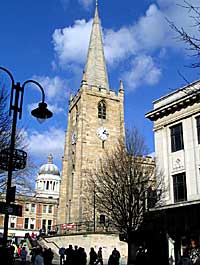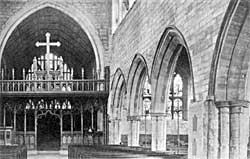St Peter's Church, Nottingham
By Mr Robert Evans

St Peter's church (Photo: A Nicholson, 2005).
In studying the history of a building, you naturally go back to the earliest printed records, and it is disappointing to find no mention of the building or parish in Domesday Book.
The foundation deed of Lenton Priory contains the first record. Sometime between the years 1103 and 1108 Wm. Peverill granted to that Priory the church of St. Mary, and also the churches of St. Peter and Nicholas, with lands, tythes, and appurtenances.
The various histories of the town agree, for the most part, as to the date of the oldest part of the present church, viz, the south arcade, the detail of which stamps it as a fine example of the Early English period, c. 1180. There are no signs of any Norman work, and in the numerous phases of restoration, no remains have been found to throw light upon the matter. In the restoration of 1886, when the south aisle was underpinned and thoroughly made safe, no remains of older foundations nor signs of Norman work were found. Opposite the wide pier between the second and third arches the remains of a wooden screen were found, which probably formed a parclose, shutting off the portion of the church to the east of it. The mouldings of these remains were much decayed and it was almost impossible to fix the date from them accurately, but they were probably of the late 14th century or early 15th.

St Peter's church, Nottingham.
In examining the south arcade you will naturally observe that the filling in of the spandrels is made with small random stones, while above, larger and more regular courses are apparent of a considerably later period. The carving to the capitals and the bosses at the intersections of the hood moulds call for a little comment, with the exception of the one at the south-east springing, which is evidently a copy of the original cockle shell.
Before leaving the south arcade, it will be as well to consider what is one of the most interesting features of the church, viz., the original stone staircase to the old rood-loft. When the present oak screen was fixed, steps were taken to find out, if possible, where the original screen was fixed, and although it was known that there were remains of a staircase, the opening at the base and the top of the present screen had not been opened for many years. It was found that a great part of the staircase was intact, and what was missing was supplied. Another point of interest was the discovery of an old altar stone, built into the wall at the top of the staircase, whether that of the main altar or of one of the chapels is not known; but the crosses at each corner and at the centre clearly prove it to be one of the original altar stones.
The projecting chamfered course to the west of the opening is difficult to understand, and no satisfactory theory has been suggested.
Before leaving this period, notice must be made of the corbels at the east and west ends, which clearly received an early pointed roof, the pitch being shown by the overhanging course.
One of the difficult points to give a reason for, is the irregular position both of the chancel and the tower arches with regard to the south and north arcades. You will notice, that in order to get over the resultant difficulty when the new screen was fixed, the cross was set up in the centre of the chancel arch and two figures placed against the opening to the rood staircase, making in all the Apostolic number.
The north arcade is a much mutilated example of Perpendicular work, probably about the end of the 14th century. The chief damage to this was done by the erection of galleries in the north aisle and in front of the tower arch which were removed in 1877. On the most easterly pier of this arcade can be seen the stays that were fixed to receive the mace and other emblems of corporate power, when the mayor, sheriff, and corporation came yearly to worship in the ancient building.
The same difficulty applies to the west end where the tower has been built without any reference to the centre of the nave.
The roofs of the nave and south aisle are clearly Perpendicular work, and although restored are not in any way altered from their original style. The north aisle is covered with a roof of considerably later date.
The original reason of this paper was to consider the recent restorations to the tower and spire. Although nothing of historical value has been brought to light during this work the following points may be of interest.
Exposure during five centuries to rain and sunshine has left its mark upon the tower and spire, but fortunately the men who selected the stone of which it is built, did so wisely, and if succeeding generations are alive to their trust and duty, we may reasonably expect that it will remain a landmark in our city for many years to come. As the church is built on lower ground than St. Mary's, the spire does not appear so prominently in a distant view of Nottingham when one approaches the city from the south or south-east, but from the weathercock on a fine day, smoke from the furnaces near Melton Mowbray may be seen; on the north and west the view is bounded by the hills on the Mansfield and Derby Roads, and on the east by Carlton Hill and Colwick Woods.
The graceful and dignified outlines of both tower and spire are well worth a careful study. Originally the spire was crocketted, the crockets being about 3ft. apart, but ninety years ago the remains of them were sawn off by a mason named Philip Wooton. The positions are still clearly defined.
It will be remembered that the apex of the spire has for years looked new, of a lighter colour than the rest of the stonework, and it appears that this part of the spire has been a source of expense and anxiety for some 200 years. When the weathercock was placed on the spire in 1735, the upper stonework (probably the original stonework) was taken down, so that the long vertical rod on which the cock revolves could be fixed in position, and ever since then this portion has been renewed, on an average, about every forty-five years.
In 1789, Robert Wooton of Kegworth, father of Philip, before-mentioned, re-built four yards of the spire and re-fixed the cock which had become insecure. He was not a nervous man and played a good many pranks at the top of his ladders during re-building, including the beating of a drum and the drinking of a bottle of ale in the sight of thousands of people on a market day. He died in the debtors' prison.
In 1825, the weathercock fell on to the nave roof, the stonework having perished; Philip Wooton was engaged to do the necessary repairs, and the weathercock rod was then embellished by the addition of a gilded copper ball. Sixteen years later, the apex again underwent repair and it was found that the rod had broken off about 6 ft. from the top. The stone used for the re-building was Mansfield, which accounts for the white appearance.
The present works of repair and renewal were long over due. There was no mortar in the joints of the spire masonry within 2in. of the external face. A great many of the joints were without any mortar at all, and the rain drove through and ran down the inner face, with the result that the joints had become very wide through the perishing of the stone. The stonework at the apex was found to be cracked and very badly weathered, and it has now been entirely removed and re-built in Derbyshire stone of a colour and composition more closely resembling that of the original stone. This stone was carefully selected after inspection of various quarries from Prince's New Dungeon Quarry, Birchover. The spire is 11 in. thick at the base and 7in. at the apex, the bed joints are horizontal, and the courses of stonework vary from 6in. to
16in. in depth. The upper 8ft. is built solid and a break in the direction of the sides of the spire, which really forms an entasis, occurs about 10½ft. above the tower leads.
The weathercock poised nearly 160ft. above St. Peter's Square, is of copper and measures 2¾ft. from beak to tail. The gilded ball beneath it is 13½in. in diameter. On the weathercock, various names and dates have been stamped or engraved from time to time. Photographs shewing these were obtained.
